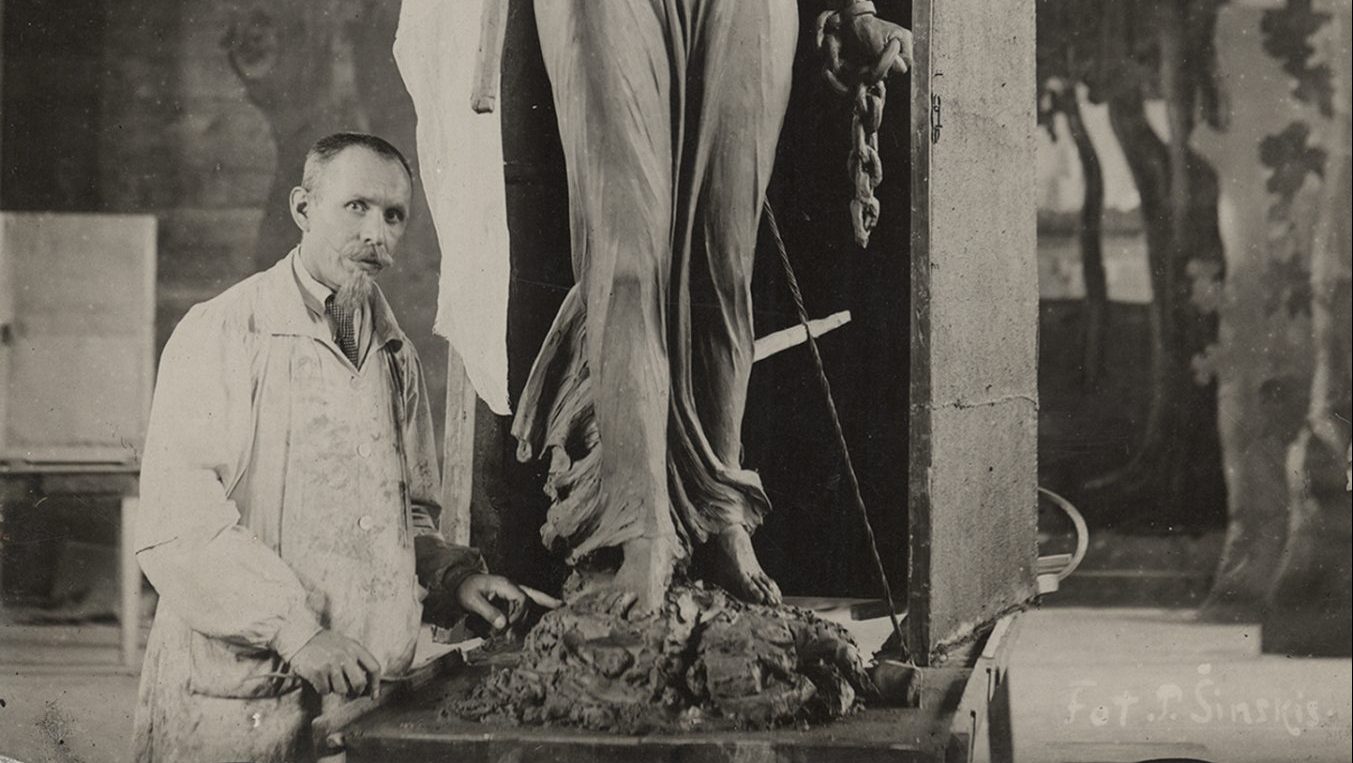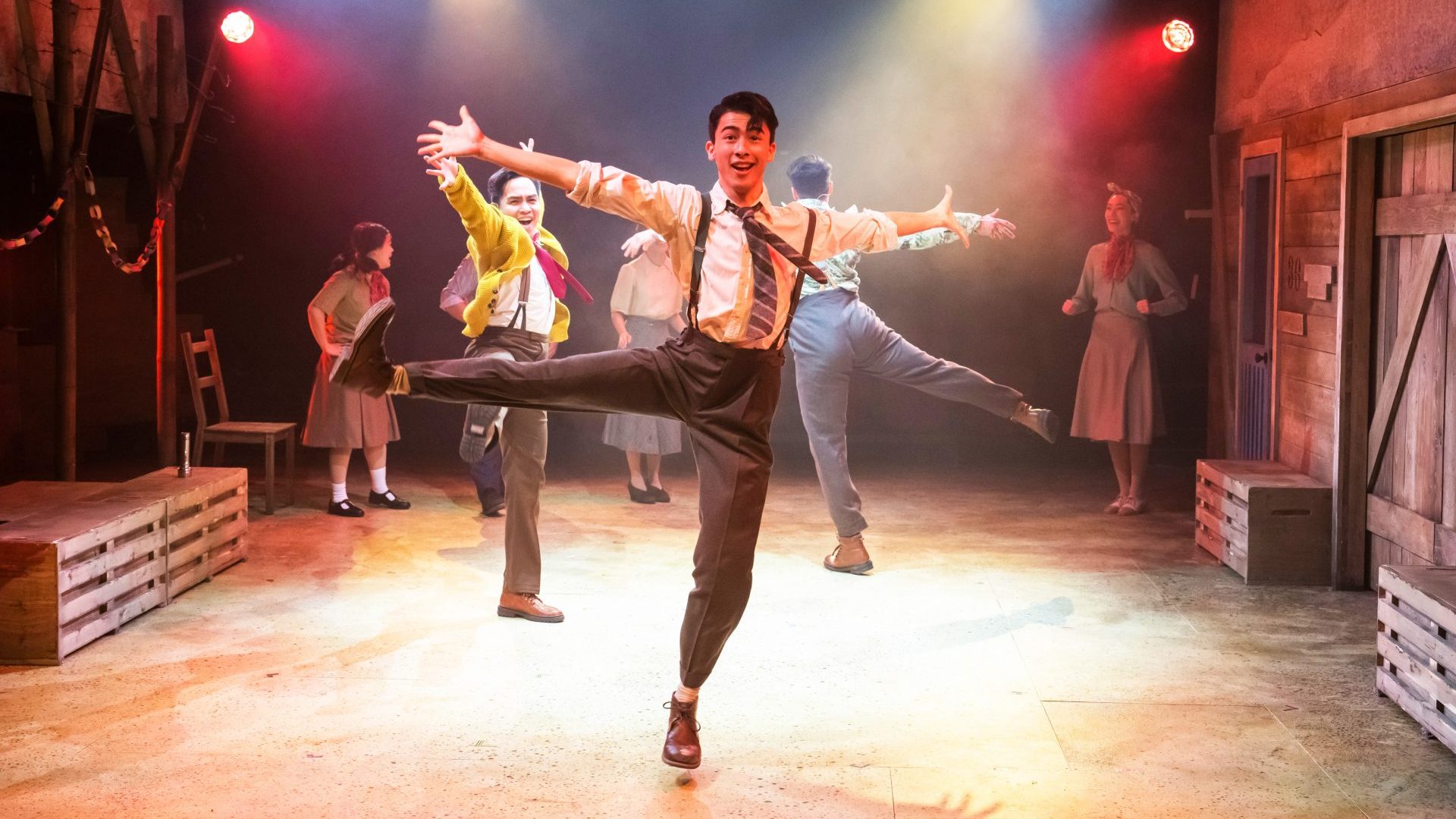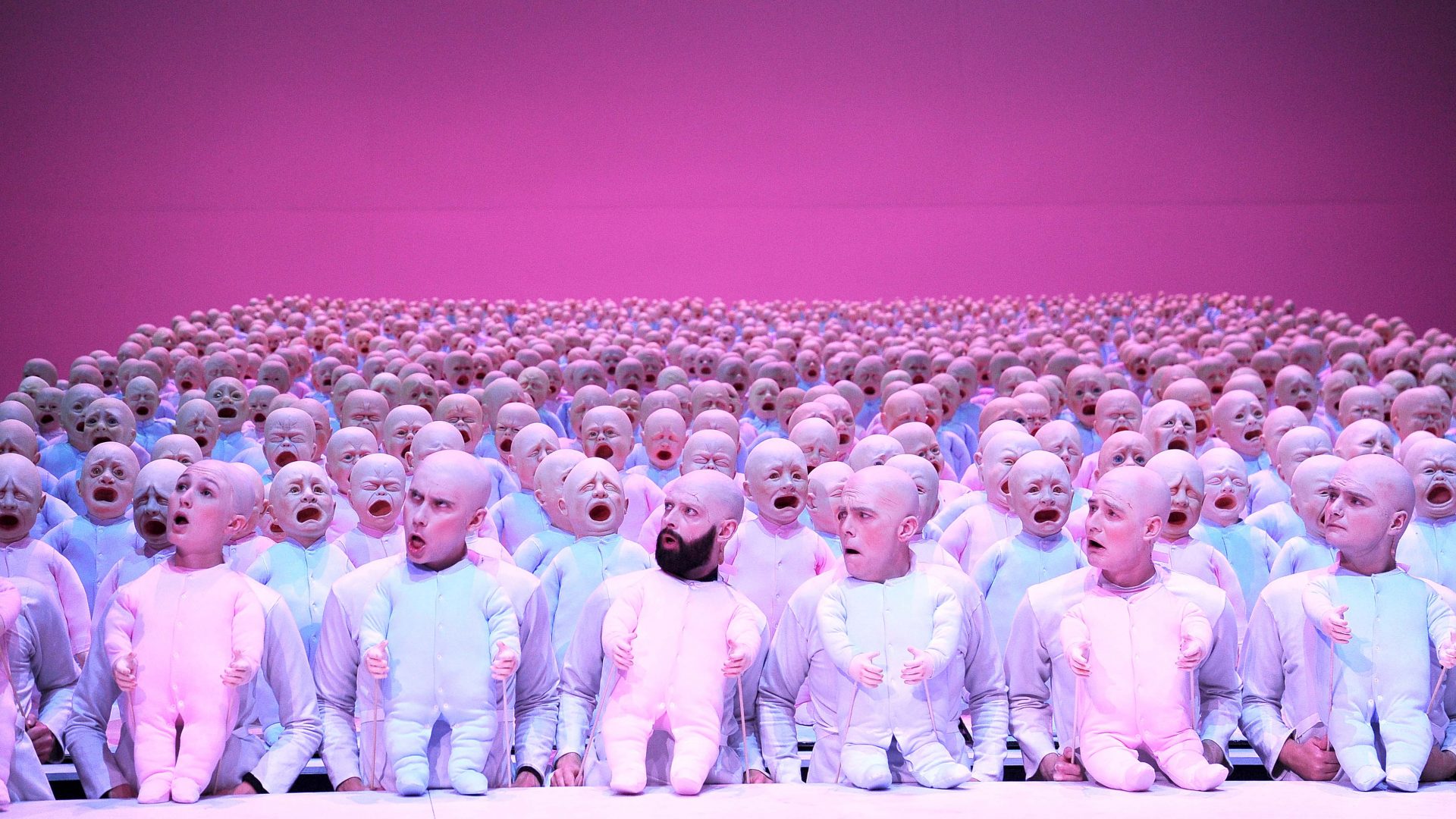In the 1940s, Lithuanian sculptor Juozas Zikaras (1881-1944) was a dangerous man. Twenty years previously, he had designed new coinage and a “Statue of Liberty” to mark Lithuania’s newfound independence, and he became synonymous with some of the country’s most enduring and powerful expressions of national identity. The Soviet Union, which occupied Lithuania until the fall of the Iron Curtain in 1991, clamped down hard on such seditious images, following a pattern of brutal suppression set by the Russian Empire in the preceding centuries.
Persecuted as a dissident, Zikaras died in 1944, effectively forced to commit suicide in exchange for the lives of his wife and daughter. Despite the extended campaign against him, much of Zikaras’s work has survived thanks to the bravery and perspicacity of his daughter, Alytė Zikaraitė (1925- 1998), an engineer whose secret museum to her father secured his place in the national pantheon.
Today, Zikaras’s Statue of Liberty – or the Freedom monument as it is also called – has been restored to its original position near the Vytautas the Great War Museum in Kaunas, now Lithuania’s second city, but its capital between 1919 and 1940. Set on an enormous plinth, the winged female figure is remote and insubstantial: it lacks the triumphant confidence of its New York sister, its ethereal appearance in keeping with Lithuania’s sometimes faltering grip on liberty.
The statue escaped being melted down by the Nazis who moved into Lithuania in 1940, but a further attempt to destroy it in 1950 was more
successful. According to Virginija Skučaitė, writing for the Baltic news
service Delfi in 2013, the statue was attacked by Soviet authorities: “The statue cracked but remained intact. The flagpole broke, the chains snapped, and the pedestal was blown up.” Miraculously, the monument was still salvageable and in 1966 it was restored, and returned in 1989 to its position outside the War Museum.
The life story of the sculptor himself follows a similarly bleak path, reflecting the darkest moments of Lithuania’s history, which has been shaped by occupation, persecution and mass suffering. Even so, the Freedom monument marks a moment of genuine optimism in Lithuania’s
national story, the bronze sculpture cast in 1928 to mark 10 years of independence, seized in the aftermath of the first world war.
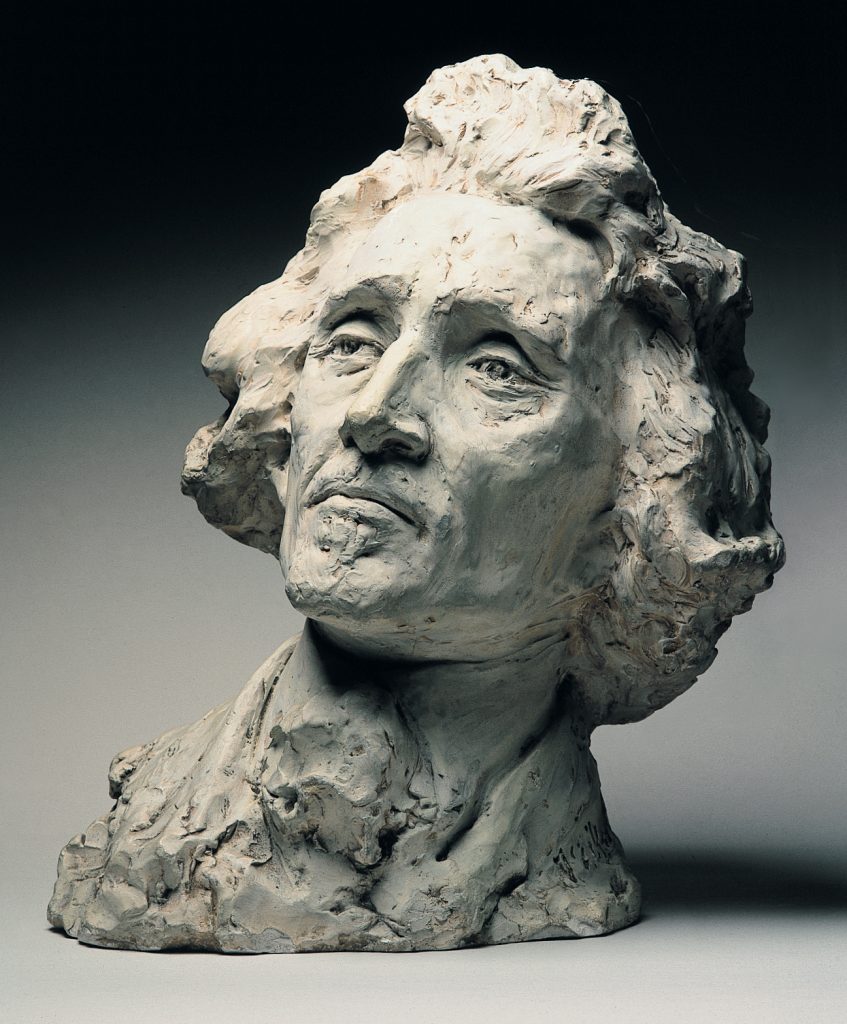
Lithuania maintained its independence until 1940 and in these relatively peaceful years, Zikaras established himself as an artist and became Lithuania’s first professional sculptor. Like his fellow countryman, the composer and painter MK Čiurlionis, whose work is on show at Dulwich Picture Gallery until March 12 2023, Zikaras began life as a musician and spent a period studying in St Petersburg before returning to Lithuania.
His first teaching post was in Panevėžys, one of Lithuania’s biggest cities, and it was here that he produced many of the most important works of his career, including Freedom and The Book Smuggler, 1928, which celebrated the resurgence of Lithuanian national identity, embodied in language and literature, that had been systematically suppressed and disrupted for as long as anyone could remember.
The heroic figure of the book smuggler has its origins in the ban on Lithuanian language publications imposed by Russia between 1864 and 1904. In response, an extensive book-smuggling operation developed, which encompassed the financing of book printing, often over the border in Prussian Lithuania. Bringing the books into Russian-controlled Lithuania was hugely risky, but it was a massive, and ultimately successful operation with upwards of 30,000 books distributed in the year before the ban was lifted.
These acts of cultural resistance were crucial in building the momentum that won Lithuania’s independence in 1918, and in the rehabilitation of national identity that followed, the arts continued to play a central role. Kaunas Art School was established at the earliest opportunity, and Zikaras, by then a senior figure, was appointed as its head of sculpture in 1928, remaining on the staff until the school closed in 1940.
His house was inaugurated as the J Zikaras House-Museum in 2001, to mark the 120th anniversary of the artist’s birth. Built from wood and smartly painted in ochre picked out with brown, Zikaras’s house is one of several around the art school, at the top of Ėuolai Hill (Owl Hill), which takes its name from Vincas Grybas’s sculpted owls, installed on the art school’s perimeter fence in 1924. High above the city of Kaunas, it offers a panoramic view of the surrounding countryside, and it comes as no surprise to discover that the hill was previously occupied by part of Kaunas Fortress, built between 1882 and 1915, and one of the strongest in the Russian Empire.
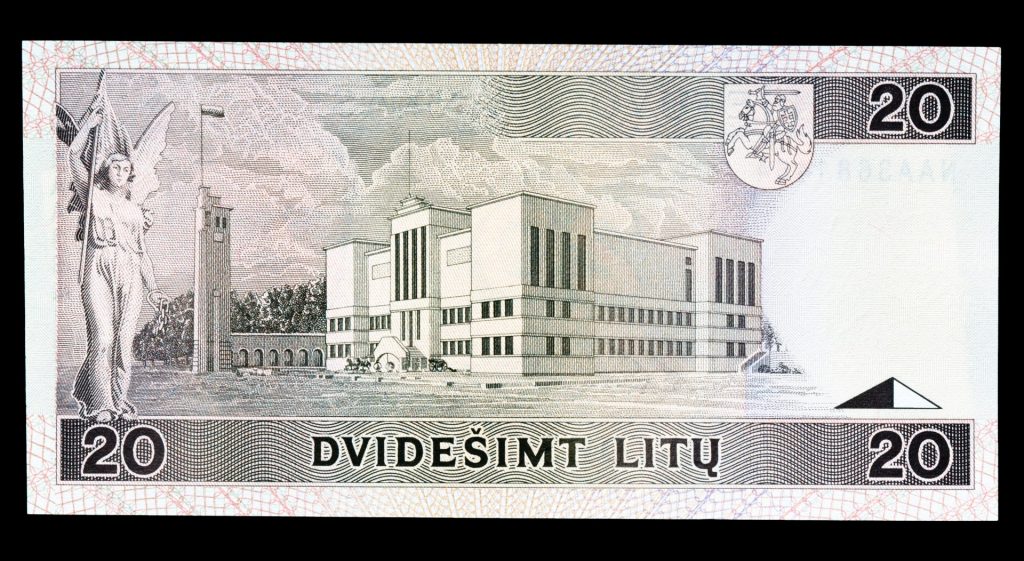
Despite its turbulent history, Zikaras’s house is a cheerful place, and for a few years the sculptor and his wife Anelė Zikarienė, and their four children – Vaidutis Zikaras, Teisutis Zikaras, Vainutis Zikaras and Alytė Zikaraitė – enjoyed a pleasant life, in what even today remain bucolic surroundings, its greenery pierced with the rosy pinks and yellows of fruit-laden cherry trees.
Speaking through an interpreter, the museum’s custodian, Rasa Ruibenė, describes a house full of friends and music, the living-room table covered
with a carpet to stop playing cards sliding about, and reminiscent of an interior in a 17th-century Dutch painting.
The house is sparingly furnished, but highlights include a rare 1930s linoleum floor, and a piano from the turn of the 20th century. The walls
are hung with works by Zikaras and his friends, creating an impression
of a convivial artistic community. His studio contains drawings and plaster casts, several versions of the Freedom monument, and examples of many other works including portraits of public figures. One of the more unusual items on display is a series of pictograms setting out his rigorous teaching programme, with each term’s work described in drawings.
Life changed for everyone in 1940, and Lithuania, along with much of
central and eastern Europe, was carved up following the Molotov-Ribbentrop non-aggression pact between Germany and Russia. Lithuania was occupied first by the Soviet Union and then by the Nazis, who by the end of the war in 1945, had overseen the murder of almost the entire Jewish population of Lithuania, recorded in the region of 160,000 people.
The art school was closed, and Zikaras’s family was threatened with deportation. Rasa Ruibienė explains: “In 1944, under German occupation,
Zikaras’s three sons were taken to build trenches. Two weeks later, the Zikaras family received a message to say that everyone who was taken from
the region, including their three sons, were dead.”
If the surviving members of the family thought that the worst had happened, they were soon proved wrong. That same year, Lithuania returned to Soviet control and Zikaras was subjected to repeated interrogations by the KGB, who refused to believe that his three sons were dead. Instead, says Ruibienė,
they insisted that Zikaras’s sons were part of the resistance force known as the Forest Brothers, anti-Soviet insurgents who fought a guerrilla war from the cover of the Baltic forests until well into the 1950s.
Zikaras was questioned three times, says Ruibienė: “The first time was quite respectful, but the second time he knew that the person in the next room was being beaten to death. The third time, he came home with broken ribs, and told his wife and daughter that they were going to be deported.”
A doctor friend supplied Zikaras with a lethal dose of morphine, which he took after writing a will in which he left everything to his wife and daughter and stated that his death was by his own hand, and that no other party was to blame. It was this, believed his daughter Alytė Zikaraitė, that saved her and her mother from deportation to Siberia, a sentence that would almost certainly have resulted in their deaths.
Some years later, in 1952, a letter arrived from the USA, sent via Poland to avoid the censors. It was from Zikaras’s sons, long presumed dead but actually alive and well, two of them having escaped to the USA and the other to Australia.
Once they learned of their father’s death, the brothers encouraged Alytė to collect as many of Zikaras’s work as possible, and sent money to help her do this. By 1959 she had assembled a secret museum, the only private museum in Lithuania.
Filled with symbols of a country fighting for its very existence, the little house must have had an almost religious aura. Alytė admitted visitors to her museum, and each year she and her friends celebrated February 16, the anniversary of Lithuania’s 1918 declaration of independence.
Over the years, many people must have known about the museum, but Alytė was convinced that anti-Soviet feeling protected her from informers. Still, there were near misses. Around 1965, after the death of Alytė’s mother, Janina Narkevičiūtė, deputy chairman of the cultural committee visited the house, and insisted on seeing what was downstairs. Alytė was forced to show Narkevičiūtė her father’s workshop and as a result Narkevičiūtė ordered the removal of some portrait busts of priests, the coins of independent Lithuania, and the Freedom monument.
Convinced that she would be arrested, Alytė was surprised to be asked instead to open her museum to a forthcoming delegation visiting from the USA. Ruibienė says: “Narkevičiūtė decided this could be a good way to show ‘those capitalists’ that private property is encouraged in Soviet Lithuania.”
The visit was a great success, and delegations from western countries continued to be brought to the museum, the government having decided that some of Zikaras’s works were suitable, so long as Alytė removed the more patriotic examples.
In the late 1980s, the “Sąjūdis” movement led the campaign for Lithuanian independence, which was officially declared on March 11, 1990. A key moment in the campaign was the return of Zikaras’s Freedom monument, the “Statue of Liberty”, to its rightful place outside the War Museum in Kaunas, followed soon after by the reintroduction of the litas coins, which once again used Zikaras’s designs.
Times have changed, and while the state currency is obsolete once again, this time it comes with membership of the EU, which with Nato affords a level of security the country has never previously enjoyed. The geography of the Baltic states, and the long shadow of history, mean that Lithuania will
always remain wary of Russia, but the spirit to resist gathers its strength in Lithuania’s rich cultural reserves, embodied in the figure of Juozas Zikaras, and his remarkable daughter.
The Zikaras House-Museum is at J Zikaro str. 3, Kaunas, Lithuania. Details of how to visit here.


